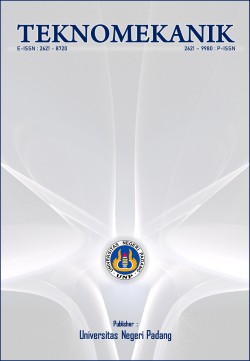Corrosion behavior of super austenitic stainless steel, Duplex 2205 and 316L in sulfamic acid environment
DOI:
https://doi.org/10.24036/jptk.v4i4.24323Keywords:
Corrosion rate, Super austenitic, Stainless steel, Duplex 2205 and 316L, Sulfamic acidAbstract
Currently, sulfamic acid as a primary chemical industrial material is ubiquitous. One of its uses is a sweetener. Due to its corrosive nature, it is necessary to use a suitable container to avoid contamination of the solution. Corrosion behavior of super austenitic stainless steel, duplex 2205, and 316L uncovered to sulfamic acid in diverse attention at ambient temperature had been investigated. Concentration Weight loss method, Potentiodynamic Polarization, and Electrochemical Impedance Spectroscopy (EIS) examined the corrosion rate. The result showed that the corrosion rate of material increased with the increasing concentration of sulfamic acid. Super austenitic stainless steel has higher corrosion resistance than duplex 2205 and 316L.
Downloads
References
Clapp L.B. (1943) Sulfamic acid and its uses, Journal of Chemical Education 20, 189-191.
Yoshikubo, Katsumasa & Suzuki, Michio (2001) Kirk-Othmer Encyclopedia of Chemical Technology, John Wiley & Sons Inc.
Winum, J.Y. (2005), Sulfamates and their therapeutic potential”, Midicinal Research Reviews 25, 186-228.
Abdel-Fatah, Hesham T.M., Kamel, Medhat M, Rashwan, Salah A.M., Wahaab, Saad M. & Hassan, Aliaa A.M. (2012). Corrosion behavior of some low chromium-molybdenum steel in sulphamic acid, Chemical Science Review and Letters, 18-24.
Abd El Rehim, Sayed S., Abdel-Fatah, Hesham T.M & El-Sehiety, Hala E.E. (2011) Inhibitive action of Cystine on the Corrosion of low alloy steel ASTM A213 grate T22 in sulfamic acid solutions, Arabian Journal of Chemistry, Elsevier.
Hermas A.A. & Morad M.S. (2008) A comparative study on the corrosion behavior of 304 austenitic stainless steel in sulfamic and sulfuric acid solutions, Corrosion Science 50, Elsevier, 2710-2717.
Kish, J.R., Stead N.J. & Singbeil D.L. (2009). Corrosion Control of Type 316L Stainless Steel in Sulfamic Acid Cleaning Solutions, Corrosion Vol.65 No.7, 491-500.
Fouda A.S., Elmorsi, M.A., Fayed, T. & El Said, I.A. (2014). Oxazole derivatives as corrosion inhibitors for 316L stainless steel in sulfamic acid solutions, Desalininization and Water Treatment, Balaban Desalinization Publication, 1-15.
Jones, D.A. (1992). Principles and Prevention of Corrosion, 2nd Edition, Prentice Hall International.
Wang, Z., Paschalidou, E-M., Seyeux, A., Zanna, S., Maurice, V. & Marcus, P. (2019). Mechanisms of Cr and Mo Enrichments in the Passive Oxide Film on 316L Austenitic Stainless Steel, Frontiers in Materials, doi: 10.3389/fmats.2019.00232.
Keller, P. & Strehblow, H. H. (2004). XPS Investigations of Electrochemically Formed Passive Layers on Fe/Cr-alloys in 0.5M H2SO4, Corrosion Sci. 46, 1939–1952.
Zhao, Wu., Zhao, Jianguo., Zhang, Shengjing. & Yang, Jinbo. (2019) Application of Electrochemical Impedance Spectroscopy to Evaluate the Corrosion Behavior of 2304 Duplex Stainless Steel Reinforced Rebar in Concrete Exposed in Chloride-Rich Environment, International Journal of Electrochemical Science, Vol.14, 8039-8047.
Chai, Guocai. & Kangas, Pasi. (2016) Super and Hyper Duplex Stainless Steels: Structures, Properties and Application, Procedia Structural Integrity 2, Elsevier, 1755-1762.
Syahril. (2012) Studi Spektroskopi Impedansi Barium Titanat Pada Temperatur Tinggi, Tesis, Universitas Indonesia.
Downloads
Published
Issue
Section
License
Copyright (c) 2021 Bashari Rohululloh Roszardi, Rini Riastuti, Wahyu Budiarto, Nono Darsono, Adi Noer Syahid

This work is licensed under a Creative Commons Attribution 4.0 International License.





